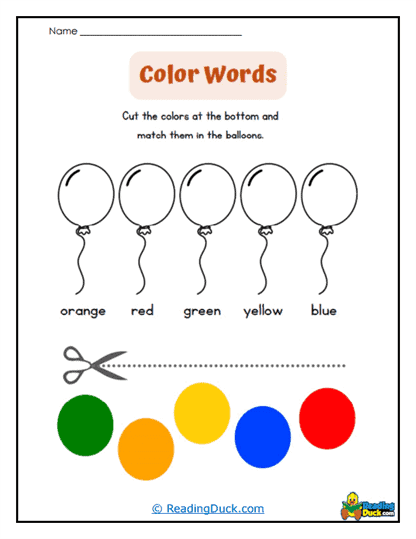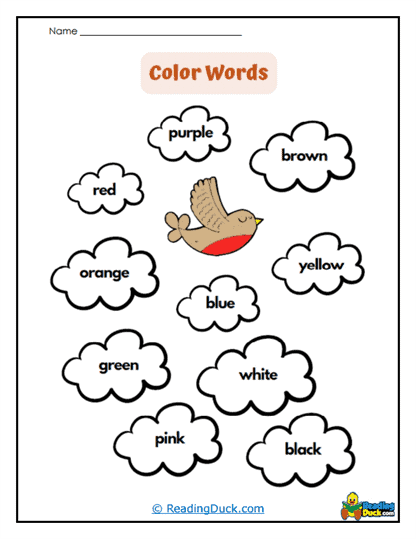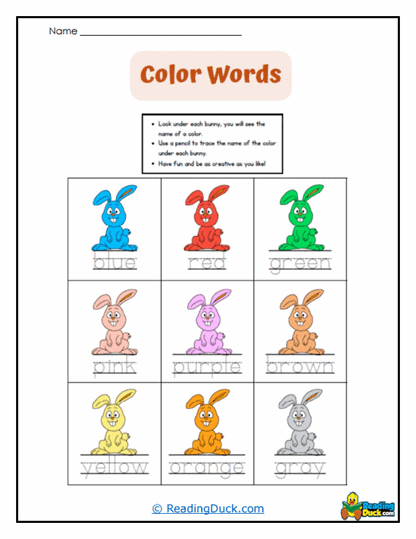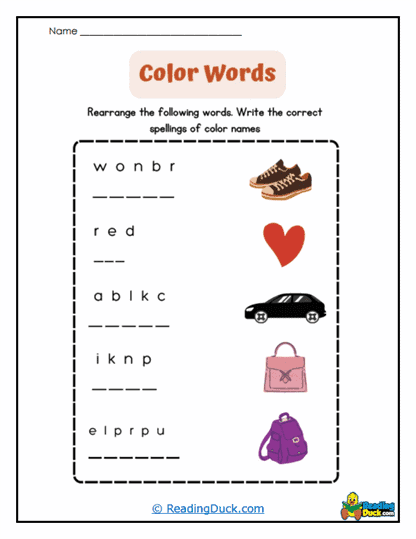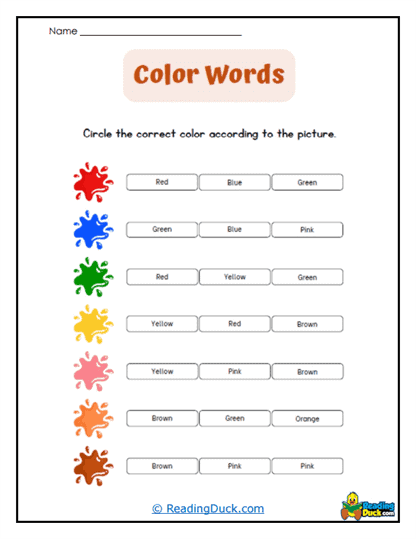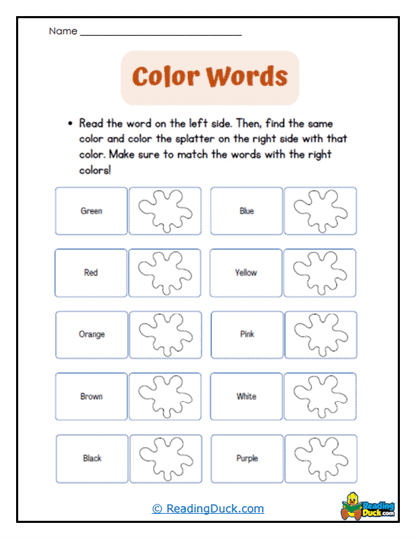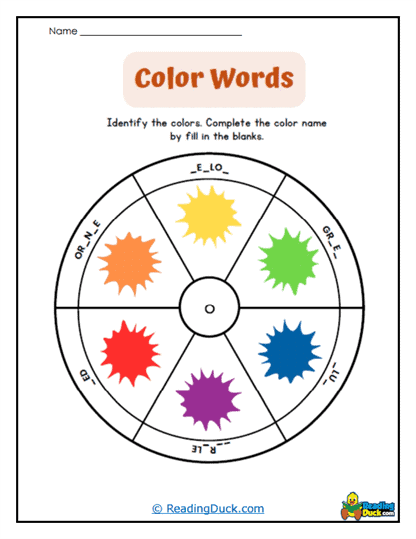Color Words Worksheets
About Our Color Words Worksheets
These worksheets will help young children learn about colors in a fun, interactive way. These worksheets use familiar themes and objects, like umbrellas, animals, and jelly beans, to capture a child's interest while building foundational color recognition skills. Each worksheet includes different activities that prompt children to identify, match, and color various items according to specific color names, making color learning relatable and enjoyable.
These worksheets are more than just coloring pages. They combine visual learning with hands-on tasks, which helps children strengthen their association between words and colors. For instance, students might be asked to color an umbrella labeled "red" with a red crayon, reinforcing both the visual appearance of the color and the word itself. These sheets are suitable for early learners, providing a structured way for them to recognize colors through repetition and visual cues.
The collection of worksheets covers a variety of learning styles and skills. Some worksheets encourage independent color recognition, while others focus on matching or sorting, fostering both individual learning and collaborative work. Through these diverse activities, children develop a deeper understanding of colors and color words, building a foundation for future learning in reading, science, and art.
By incorporating everyday items and themes, these worksheets provide cultural and contextual relevance. Items like fruit, animals, and toys make learning more meaningful, helping children connect what they see on the worksheets with the real world around them. This approach makes color learning feel like a natural part of their daily experience, reinforcing the skills they’re developing in a familiar context.
Student Tasks
These worksheets offer a variety of tasks to keep young learners engaged and active. Each task is carefully crafted to support color recognition while enhancing other essential skills. Here are some of the main types of activities featured in these worksheets:
Matching Colors with Objects - One of the core exercises is to match color names with corresponding objects. For instance, children might see a picture of a blue jelly bean and match it with the color word "blue." This helps them associate specific colors with their names and the items they see in real life, creating a cognitive link between words and visuals. Through this process, they begin to make connections that extend beyond the worksheet, identifying colors in their environment and understanding that colors are part of the world around them. Additionally, these activities support vocabulary building as children pair abstract concepts with tangible examples, reinforcing their understanding of language. By engaging their senses in this matching exercise, children become more observant, learning to look for and recognize colors in everyday objects around them.
Color Sorting and Association - Some worksheets encourage students to cut out color names or colored sections and paste them next to matching pictures. This type of task not only supports color recognition but also enhances fine motor skills, as children must carefully cut and place the pieces. Sorting and associating colors with images also reinforce logical thinking as they decide which colors fit where. The act of cutting, arranging, and gluing pieces strengthens their hand-eye coordination, which is vital for tasks like writing and drawing. Furthermore, these activities require decision-making, prompting children to think critically about their choices as they consider which colors belong with each object. This practical, hands-on activity makes learning engaging, helping young students feel more involved in their education by using a combination of visual and tactile experiences.
Pattern and Set Matching - Activities that involve matching patterns or sets based on color help children recognize repetition and grouping. For example, they may be asked to match pairs of objects, like matching colored balloons or arranging items with similar colors. These exercises build an understanding of patterns and sequencing, both of which are foundational for mathematical skills. Recognizing patterns trains children’s brains to identify predictable relationships and develop early problem-solving strategies. This skill becomes especially important as they learn more complex concepts in math, like counting, addition, and multiplication. By working with visual patterns, they not only improve their visual perception but also gain confidence in organizing information logically-a skill that will benefit them in every subject area.
Coloring Within the Lines - In addition to color recognition, many of these worksheets encourage children to color within specific shapes or outlines. Coloring within the lines helps young learners improve pencil control and attention to detail. This skill, although simple, is crucial for developing steady hand movements and focus, which are essential for writing and drawing as they progress in their education. Coloring inside the lines is a structured way to teach patience and precision, as it requires children to take their time and be mindful of their work. This practice also instills a sense of pride and accomplishment as children complete their artwork with care, fostering positive feelings toward learning. As students become more proficient, they develop a strong foundation for writing letters and numbers, setting them up for success in literacy and numeracy skills.
Skills Developed
Working on "Color Words" worksheets fosters a wide range of skills beyond just color identification. Here’s a look at some of the key skills that these worksheets help develop:
Color Recognition
The primary purpose of these worksheets is to help young learners recognize and distinguish colors, a fundamental skill in early education. By repeatedly identifying color names and associating them with various objects, children start to build a strong visual vocabulary, linking specific colors to words. This repeated exposure to colors enhances their visual discrimination skills, allowing them to notice and appreciate subtle differences between shades, a cognitive ability that supports early reading, spatial awareness, and observational skills. Teaching color recognition also has social benefits, as children learn to describe what they see with greater accuracy, supporting clearer communication and language development. For teachers, using these worksheets means you’re not just teaching colors but helping children sharpen their observational skills, setting a strong foundation for many other subjects.
Fine Motor Skills
The tasks in "Color Words" worksheets, such as cutting, coloring, and tracing, are excellent exercises for developing fine motor control, a crucial skill for young learners. Using pencils, crayons, and scissors in a structured way helps children build hand-eye coordination, precision, and dexterity, all of which are necessary for writing, drawing, and other activities requiring controlled movements. Developing these fine motor skills early on is essential for improving their grip and control, making future writing tasks smoother and less challenging. As children practice these skills, they also gain a sense of independence and pride in their ability to manipulate tools effectively, which enhances their confidence. For teachers, these worksheets are like a two-in-one tool: while students are learning colors, they’re also getting vital practice in physical skills that will support their success in almost every school subject.
Problem-Solving and Categorization
These worksheets are more than coloring exercises-they also encourage children to engage in problem-solving and categorization. By sorting, matching, or grouping objects based on color, children learn to recognize relationships and patterns, which enhances their ability to think critically about the world around them. This process of sorting and categorizing not only boosts logical thinking but also builds foundational skills needed in math and science, where children will frequently encounter the need to group, classify, and sequence information. Problem-solving through color association also encourages decision-making, as children decide where each color fits, which strengthens their independence and critical thinking abilities. For teachers, these worksheets offer a fun, accessible way to introduce students to basic problem-solving concepts that will be valuable as they progress in their educational journey.
Attention to Detail
Activities in our "Color Words" worksheets require children to focus on specific details, like staying within lines when coloring or making sure colors match correctly, fostering a habit of precision and mindfulness. Practicing attention to detail is important as it teaches students to slow down, observe closely, and be meticulous in their work, qualities that are beneficial across all areas of learning. Over time, this focus translates into better concentration and improved work habits, which help students complete more complex tasks with greater accuracy and confidence. Developing an eye for detail also strengthens children’s ability to notice small differences, which is a valuable skill in everything from reading to scientific observation. For teachers, these worksheets serve as an engaging way to encourage students to pay attention to small details, helping them cultivate a careful approach to both schoolwork and problem-solving in everyday life.
The Importance of These Worksheets
These worksheets are valuable tools in early education, especially for primary educators and homeschoolers. They provide structured yet engaging ways to introduce foundational skills and concepts essential for young learners. Here’s why these worksheets are so beneficial:
Foundational Learning
Recognizing and naming colors is one of the earliest cognitive milestones, giving children a foundational skill that’s vital for understanding and interacting with their world. When children can name colors, they gain a tool to describe what they see, helping them express themselves more clearly and confidently. Additionally, linking colors with words fosters vocabulary expansion as they learn to communicate about their surroundings in detail; phrases like “the red apple” or “the blue sky” become part of their expressive language toolkit. As they develop this descriptive language, children are not only building their vocabulary but also strengthening essential communication skills, setting the stage for more complex language development in the future. For teachers, these worksheets become a gateway to enriching a child's language abilities in ways that feel natural and fun.
Engagement and Motivation
These worksheets captivate young learners with their vibrant visuals, making color learning an exciting adventure rather than a chore. The use of bright colors and recognizable objects keeps children engaged, as they naturally gravitate towards activities that are visually stimulating. This engagement helps children immerse themselves in the task at hand, leading to a deeper focus and active participation, which are critical for effective learning. When students find joy in their learning activities, their retention improves as they are more likely to remember and apply what they’ve learned. For teachers, this means that “Color Words” worksheets can transform a typical lesson into an engaging experience that students look forward to, fostering a positive and enthusiastic approach to learning.
Preparatory Skills for Further Learning
Color recognition and fine motor skills are not just early skills; they’re the building blocks for future academic achievements. As children identify colors, cut shapes, and color within lines, they are developing coordination, precision, and focus, which are essential in subjects like writing, math, and art. Following instructions and completing these tasks also helps children practice discipline and organization-skills that will be crucial for more complex learning as they move through school. By using “Color Words” worksheets, teachers are providing a fun and structured way for children to practice these foundational skills, effectively preparing them for the demands of a more rigorous curriculum in reading, STEM, and beyond. This approach supports a child’s overall growth, making the transition to higher learning levels smoother and more successful.
Cultural and Contextual Relevance
By incorporating familiar objects like animals, fruits, or toys, these worksheets bridge the gap between classroom learning and the real world. When children see items they recognize, it gives them a sense of familiarity and comfort, making it easier for them to connect the new information with their daily experiences. This contextual learning makes color recognition more meaningful, as children can apply their knowledge outside the classroom by identifying colors in their natural environment. This kind of connection also reinforces the relevance of learning, showing children that education is not just about worksheets but about understanding and interacting with their world in a more meaningful way. For teachers, culturally relevant content not only enhances the learning experience but also provides a way to relate the curriculum to each child’s unique background and interests, promoting inclusivity and engagement.
